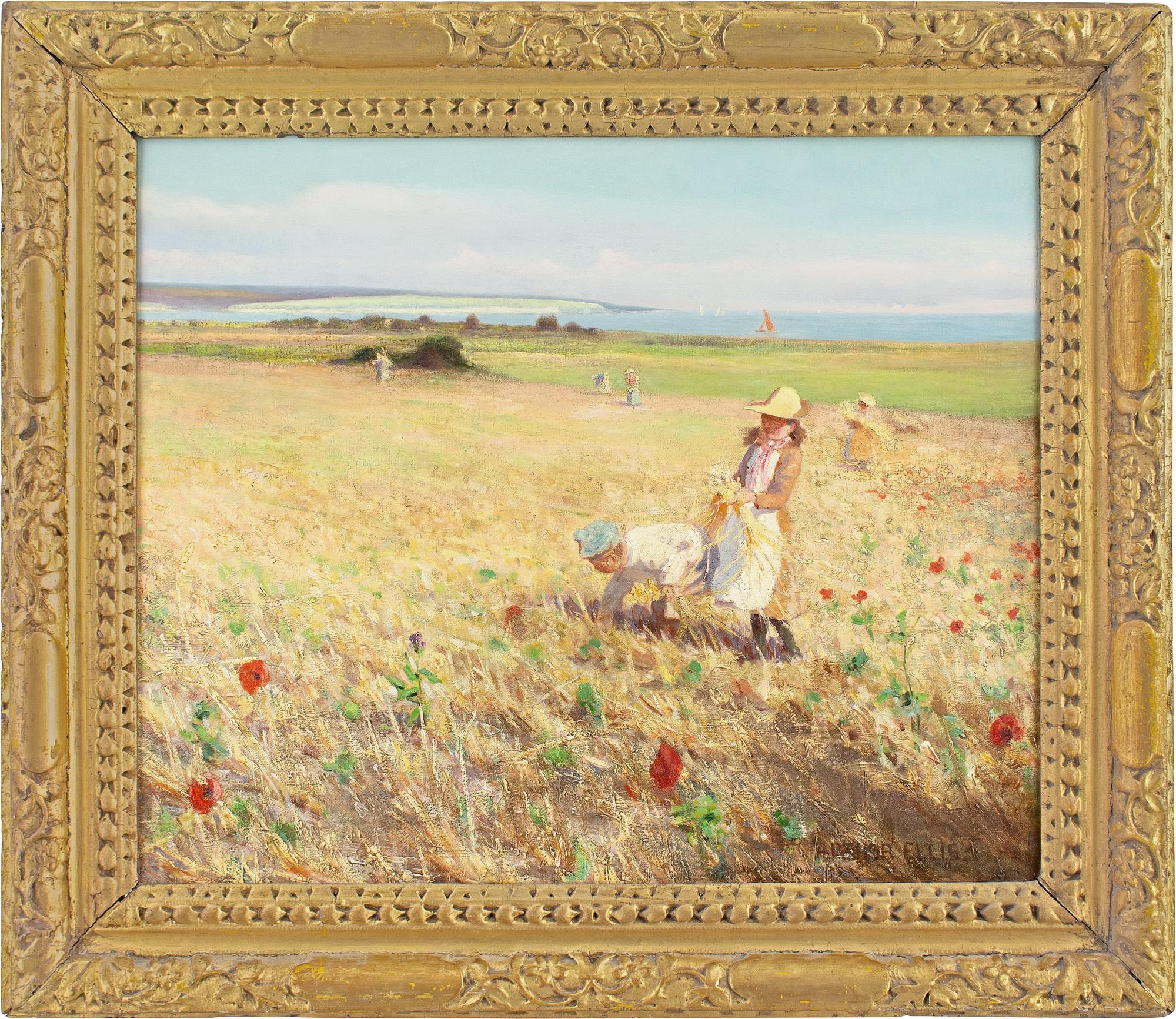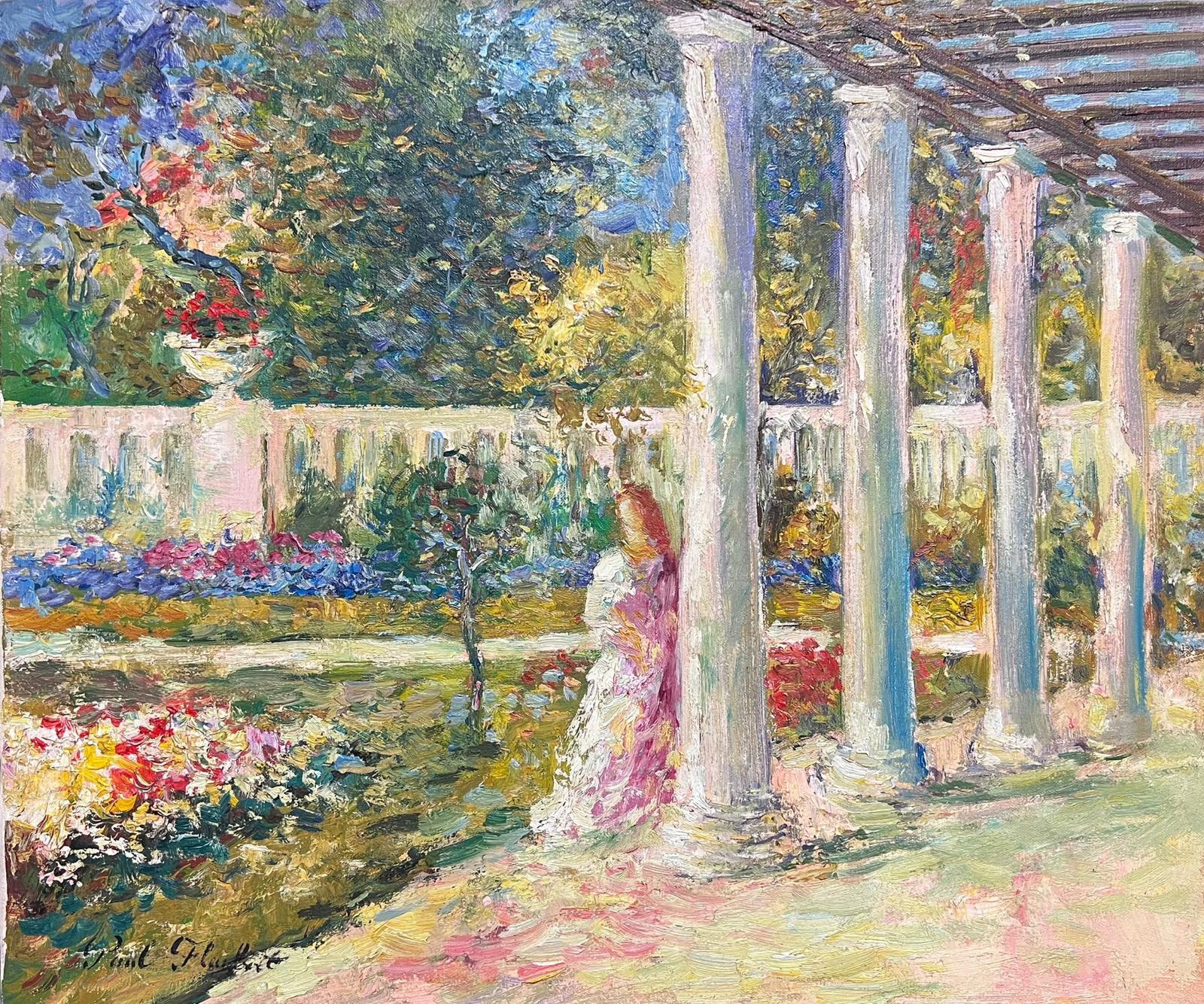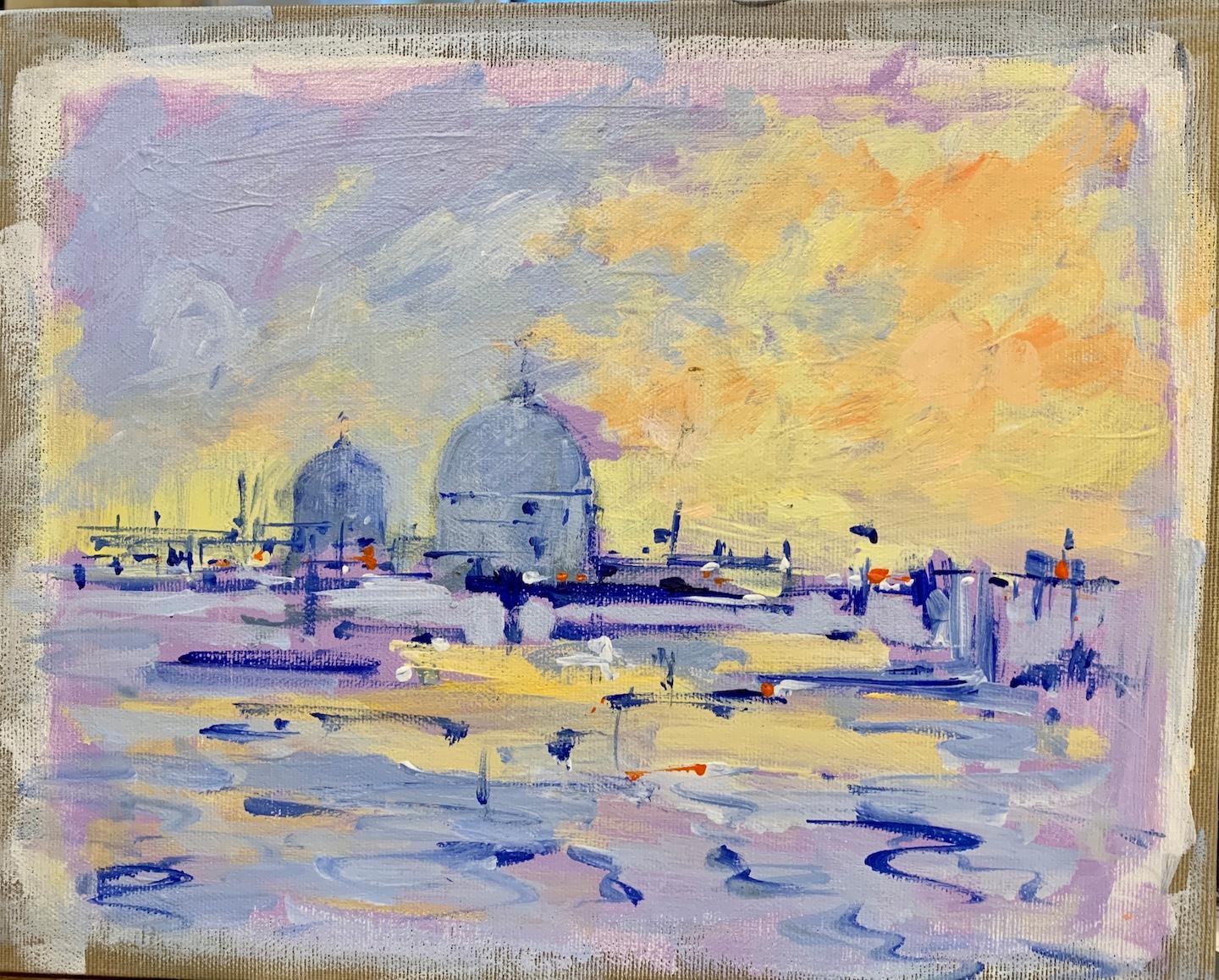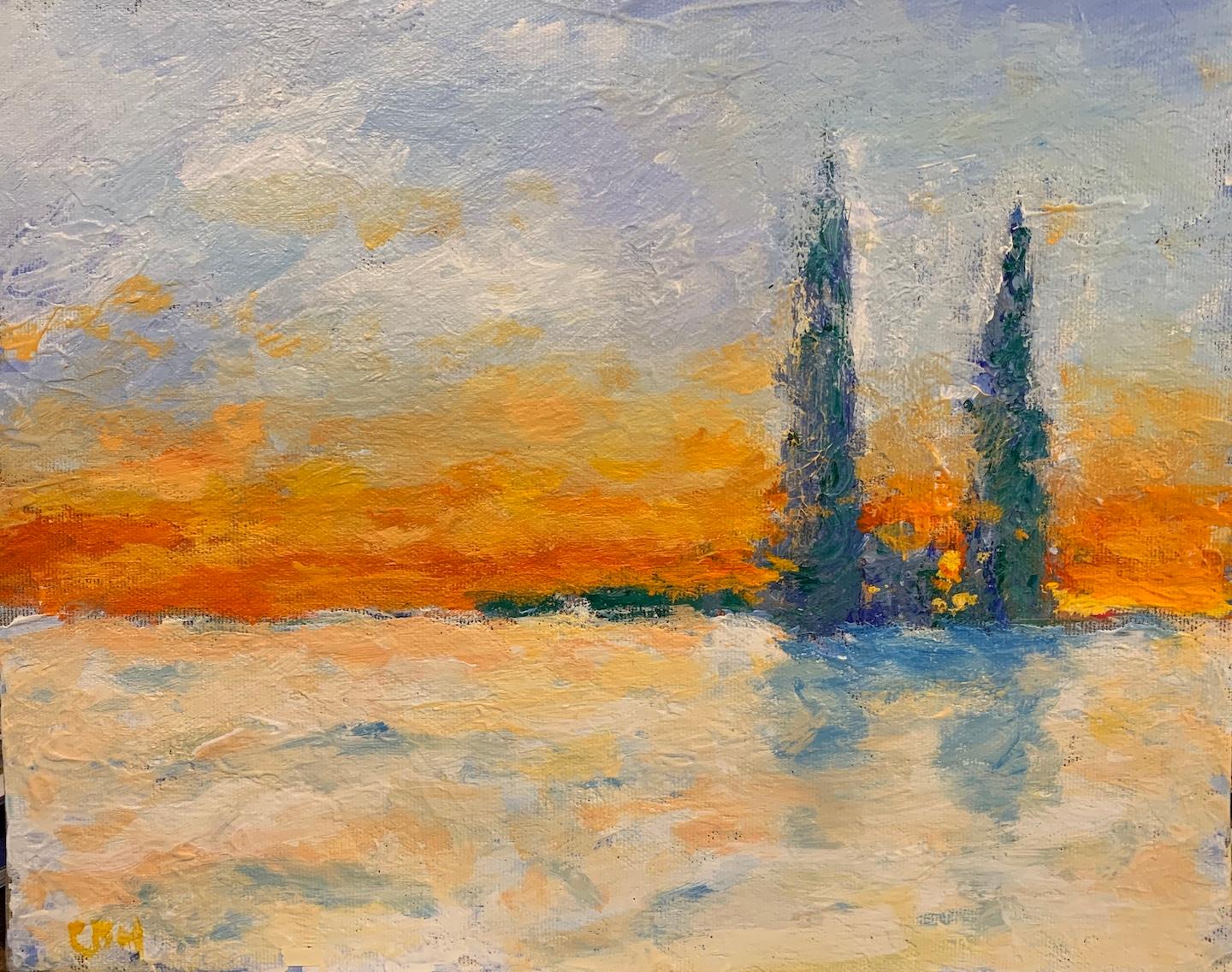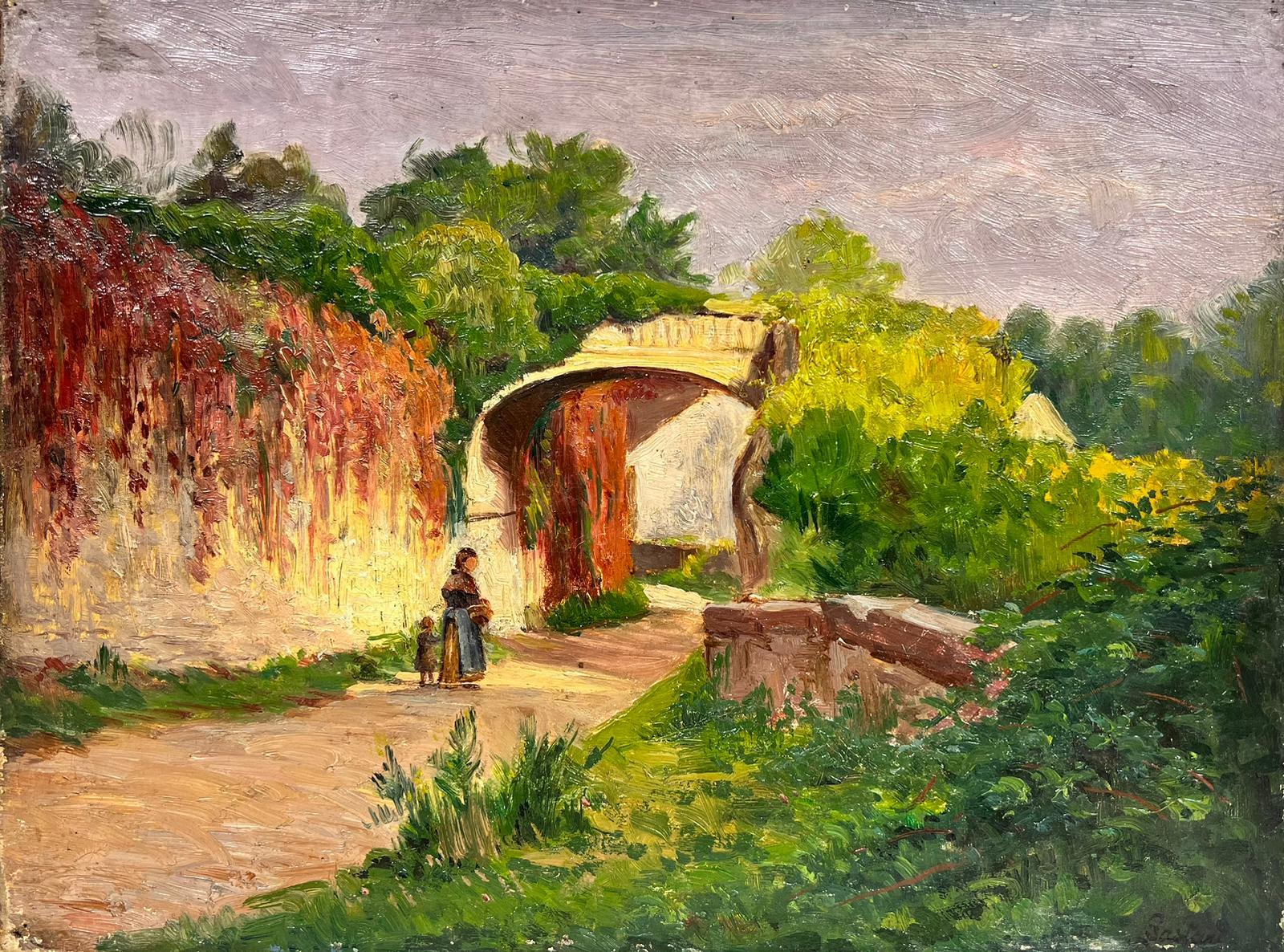Items Similar to Belandre au Soleil - Matin de Givre - Impressionist Oil, Landscape by H Duhem
Want more images or videos?
Request additional images or videos from the seller
1 of 15
Henri DuhemBelandre au Soleil - Matin de Givre - Impressionist Oil, Landscape by H Duhem1900
1900
About the Item
A large oil on canvas by French Impressionist painter Henri Duhem depicting men on a blander - a small flat bottomed craft - on a canal on a frosty morning. Signed lower left. This painting is not currently framed but a suitable frame can be sourced if required.
Descendant of an old Flemish family, Henri Duhem was born in Douai on April 7, 1860. He worked as a lawyer at the Bar of the Court of Douai from 1883, he practiced at the same time his passion for drawing and watercolor. In 1887, he enrolled in Henri Harpignies’ drawing course in Paris and, at the same time, befriended the painter Émile Breton, who introduced him to oil painting. It is with the niece of this painter, Virginie Demont-Breton, daughter of the painter Jules Breton, and herself a painter they formed the Ecole de Wissant with Georges Maroniez, Francis Tattegrain, Fernand Stievenart and Felix Planquette.
In 1889 he met a young woman painter, Marie Sergeant (1871-1918 ), that he married the following year. They had a son, Remy (1891-1915).
Now a recognized artist, Henri Duhem abandoned his career as a lawyer in 1893 to devote himself solely to his art. He became close friends with Auguste Rodin, Camille Pissarro, Gustave Caillebotte and his closest friend Henri Le Sidaner.
Together with his wife, he travelled extensively to Italy, Holland, Belgium, England, North Africa and regularly to Paris for trade fairs. Every summer, he stayed at his house in Camiers, where he painted with his wife and friends. He exhibited more and more abroad, including Chicago, Prague and Madrid, encouraged and supported by Camille Pissarro. Thus, in April 1902, Camille Pissarro wrote to Henri Duhem:
“I went a second time to the show. I could see at your ease your beautiful picture of sheep parked in the plain. I was happy to see that you like nature simple and harmonious, unlike the noise of your neighbors, that you do not dazzle by a lightning execution so attractive to the general public.”
During the First World War, he lost his son Remy, also a painter, who was killed in the assault on Les Éparges on June 20, 1915. Marie Duhem was very affected by the death of her son, and she died in Douai, in 1918, during the German occupation. Henri Duhem, left alone.. His painful memories, related to the loss of his son and his wife, are recorded in a story called The Death of the Home (Éditions Figuière, 1922).
During the inter-war years, Henri Duhem remained active on the artistic level: he took part in the creation of the Salon des Tuileries in 1923. He therefore shared his life between Douai and Paris, where he lived in the 16th arrondissement, and met Anatole de Monzie, a politician and art lover, who encouraged him to continue his work.
His health deteriorated, and in the face of the threat of a Second World War, Henri Duhem definitively left the North in 1937 to settle in Juan-les-Pins, at the villa “Mount Riant”. He died there on October 24, 1941, during the German occupation. He bequeathed his collection of paintings to his adopted daughter, Nelly Sergeant-Duhem, who, responding to the wishes of his father, gave the entire collection to the Academy of Fine Arts in 1985. It is thus kept at the Marmottan Museum in Paris. One can discover works such as the Promenade near Argenteuil painted in 1875 by Claude Monet or Bouquet of flowers painted in 1897 in Tahiti by Paul Gauguin.
He had regularly presented his works at the Salon of the National Society of Fine Arts. He had two solo exhibitions dedicated to him in Paris, under the patronage of the art critic Roger Marx: one in 1904, at the Druet Gallery, another in 1908, at the Georges Petit Gallery.
In June 1919, a new solo exhibition was dedicated to him, still at the Georges Petit Gallery, including 82 watercolors dedicated to the Great War in the occupied North. In 1926 he was elected a corresponding member of the Academy of Fine Arts and in 1932 he was promoted to the rank of Commander of the Legion of Honor.
His art is closer to the intimacy of his friend Henri Le Sidaner. Post-Impressionist, his works express the latent poetry of things, through simple themes: flocks of sheep, riversides and canals, mills, snow landscapes, millstones and fieldwork, with a game on sensitivity of effects due to changes in light; the effects of dawn or evening.
Works in public collections:
Arras, Museum of Fine Arts
Bailleul, Benoît-De-Puydt museum
Blackburn, Blackburn Museum and Art Gallery
Cambrai, Museum of Cambrai
Douai, Museum of Chartreuse
Museum of Étaples-sur-Mer
Lille, Palace of Fine Arts
Lyon, Museum of Fine Arts Lyon
Marmottan Museum – Paris
Orsay Museum – Paris
- Creator:Henri Duhem (1860 - 1941, French)
- Creation Year:1900
- Dimensions:Height: 21 in (53.34 cm)Width: 29 in (73.66 cm)
- Medium:
- Movement & Style:
- Period:
- Condition:Very good condition.
- Gallery Location:Marlow, GB
- Reference Number:
About the Seller
5.0
Platinum Seller
These expertly vetted sellers are 1stDibs' most experienced sellers and are rated highest by our customers.
Established in 2001
1stDibs seller since 2016
671 sales on 1stDibs
Typical response time: 3 hours
- ShippingRetrieving quote...Ships From: Marlow, United Kingdom
- Return PolicyA return for this item may be initiated within 3 days of delivery.
More From This SellerView All
- Marche aux Fleurs - Impressionist Landscape Oil Painting by Edouard CortesBy Édouard Leon CortèsLocated in Marlow, BuckinghamshireSigned impressionist oil on canvas cityscape circa 1960 by French painter Edouard Leon Cortes. The work depicts figures in the flower market at the Place de la Madeleine in Paris, Fr...Category
1960s Impressionist Figurative Paintings
MaterialsCanvas, Oil
- Belandre au soleil couchant - Impressionist Oil, Landscape by Henri DuhemBy Henri DuhemLocated in Marlow, BuckinghamshireSigned, titled and dated impressionist landscape oil on canvas by French painter Henri Duhem. The work depicts a barge moored on the side of the river with two men on the path on the riverbank. The sun is setting creating the most beautiful shades of pink and yellow in the sky which is reflecting in the water below. Signature: Signed lower right and titled and dated 1933 verso Dimensions: Unframed: 15"x18" This painting is not currently framed but a suitable frame can be sourced if required Provenance: Exhibited at the Salon des Tuileries - 1933 Private French collection Descendant of an old Flemish family, Henri Duhem was born in Douai on April 7, 1860. He worked as a lawyer at the Bar of the Court of Douai from 1883, he practiced at the same time his passion for drawing and watercolor. In 1887, he enrolled in Henri Harpignies' drawing course in Paris and, at the same time, befriended the painter Émile Breton...Category
1930s Impressionist Landscape Paintings
MaterialsCanvas, Oil
- The Canal at Douai - 19th Century Landscape Riverscape with Boats by Henri DuhemBy Henri DuhemLocated in Marlow, BuckinghamshireOil on canvas circa 1910. Signed lower left. This painting is not currently framed but a suitable frame can be sourced in if required. Descendant of an old Flemish family, Henri Duh...Category
Early 20th Century Impressionist Landscape Paintings
MaterialsOil, Canvas
- Painting en plein air - Impressionist Figure in Landscape Oil by Charles AngrandBy Charles AngrandLocated in Marlow, BuckinghamshireSigned and dated oil on canvas by French impressionist painter Charles Theophile Angrand. This wonderful and good-sized piece depicts an artist painting "en plain air" in a beautiful...Category
1880s Impressionist Figurative Paintings
MaterialsCanvas, Oil
- Peniches sur la Seine - Impressionist Landscape Oil - Armand GuillauminBy Jean Baptiste-Armand GuillauminLocated in Marlow, BuckinghamshireSigned impressionist landscape oil on canvas by French painter Jean Baptiste Armand Guillaumin. The work depicts barges moored on the b...Category
1880s Impressionist Landscape Paintings
MaterialsCanvas, Oil
- Bord De Mer - Impressionist Coastal Landscape Oil Painting by Willy SchlobachBy Willy SchlobachLocated in Marlow, BuckinghamshireSigned and dated pointillist landscape oil on canvas by Belgian impressionist painter Willy Schlobach. The piece depicts a coastal view looking out over the dark green sea to where it meets the powder blue sky on the distant horizon, with rock formations on either side. This work was executed in 1907 - the definitive mature period for Schlobach's work. Paintings by the artist executed between 1906 and 1908 are the pinnacle of his oeuvre and show the influence and ideas of neo impressionism brought by his friend and compatriot Theo van Rysselberghe who had learnt from Signac and Seurat in Paris. Schlobach painted numerous coastal views in this period which display a free approach to pointillism with theory being displaced by a desire to create luminosity and effect. Signature: Signed lower right and dated 1907 Dimensions: Framed: 29"x33" Unframed: 20"x24" Provenance: Private French collection Further information: This work was executed in 1907 - the definitive mature period for Schlobach's work. Paintings by the artist executed between 1906 and 1908 are the pinnacle of his oeuvre and show the influence and ideas of neo impressionism brought by his friend and compatriot Theo van Rysselberghe who had learnt from Signac and Seurat in Paris. Schlobach painted numerous coastal views in this period which display a free approach to pointillism with theory being displaced by a desire to create luminosity and effect. Willy Schlobach first studied at the Academy in Brussels and then later in Ghent. At the precocious age of nineteen he was already at the forefront of painters in Belgium numbering among his close friends Emile Verhaeren and Theo van Rysselberghe whose instructive influence on him was of great significance. He was one of the founding members of the group 'Les XX' who were broadly speaking avant-garde and influenced by the Parisian developments in painting but by no means uniform in their style or approach (see also have lots 201 and 233). Octave Maus, a lawyer and critic was the driving force behind 'Les XX' but the most important painter was Theo van Rysselberghe. Van Rysselberghe had lived and worked in Paris and brought to Belgium an intimate knowledge and understanding of the Neo-Impressionist techniques of Seurat and Signac which were to be a great influence on the younger generation of Belgian painters such as Willy Finch and Willy Schlobach. In the late 1880s Schlobach responded with enthusiasm to these new ideas emanating from Paris and produced some well structured and highly organised pointillist work in which his favoured subject matter was coastal scenes. Schlobach was also influenced by the other main group within 'Les XX' which was best represented by Fernand Khnopff. As well as working in a pointillist manner he produced paintings full of symbolism and reminiscent of the Pre-Raphaelites whose work he had studied and admired on visits to England. It is, however, in the neo-impressionist or luminist work that Schlobach found greater freedom of expression away from the sometimes claustrophobic subject matter of the symbolists. On his visits to London Schlobach had been influenced not only by the Pre-Raphaelite painters but also by the work of Turner whose atmospheric and misty paintings...Category
20th Century Impressionist Landscape Paintings
MaterialsOil, Canvas
You May Also Like
- Arthur Ellis, Children In A Cornfield, Oil PaintingBy Arthur EllisLocated in Cheltenham, GBThis beautiful early 20th-century oil painting by British artist Arthur Ellis (1856-1918) depicts children in a cornfield before a distant view of the sea. Ellis was first and forem...Category
Early 1900s Impressionist Landscape Paintings
MaterialsCanvas, Oil
- French Impressionist Signed Oil Painting Elegant Lady Pretty Flower GardenLocated in Cirencester, GloucestershireThe Garden Terrace by Paul Flaubert (French, 1928-1994) signed oil on canvas, unframed canvas: 18 x 21.5 inches provenance: private collection, France condition: very good and sound ...Category
Mid-20th Century Impressionist Figurative Paintings
MaterialsCanvas, Oil
- Impressionist sketch of a Morning sunrise over the Grand Canal, Venice, ItalyBy Charles Bertie HallLocated in Woodbury, CTOutstanding Impressionist sketch of a Morning sunrise over the Grand Canal, Venice, Italy Charles Bertie Hall painted scenes all over England, Eu...Category
2010s Impressionist Landscape Paintings
MaterialsCanvas, Oil
- American Impressionist sketch of a setting Sun in Aspen, Colorado, with snowBy Charles Bertie HallLocated in Woodbury, CTOutstanding American Impressionist sketch of Sun Set in Aspen Colorado Charles Bertie Hall painted scenes all over England, Europe, and America i...Category
2010s Impressionist Landscape Paintings
MaterialsOil, Canvas
- 1900’s French Impressionist Oil Mother & Child Walking Country Lane in SunshineLocated in Cirencester, GloucestershireFrench Impressionist painter, early 1900’s oil painting on canvas, unframed painting: 10 x 13 inches provenance: private collection, France condition: overall very good, minor losse...Category
Early 20th Century Impressionist Figurative Paintings
MaterialsOil, Canvas
- Oil Painting of Irish Countryside Scene with Cathedral in the distance IrelandLocated in Preston, GBOil Painting of a beautiful Irish Countryside Scene with Down Cathedral in the distance, Northern Ireland Art measures 12 x 16 inches Frame measure ...Category
Late 20th Century Impressionist Landscape Paintings
MaterialsCanvas, Oil
Recently Viewed
View AllMore Ways To Browse
Large Dutch Landscape
1900 Paintings From Germany
Early 20 Century Impressionist Oil Painting
Large Early 20th Impressionist Painting
Flemish Flowers Painting
Sheep And Landscape Framed Oil Paintings
Flemish Landscape Oil Painting
Flemish Flower Painting
Small Oil Landscape Early 20th Century
Prague Oil Painting
Petit H
African Art 1900
Tahiti Art
1900 Landscape Large Canvas
Dutch Post Impressionist
French Sheep Painting
Flower Bouquet Pin
Juan Les Pins
